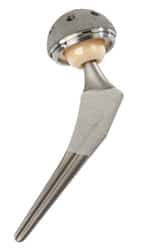The Best Solution for Your Hip Pain
Hip replacement procedures are currently considered one of the safest implant procedures performed today, with over 200,000 total hip replacements performed every year in the United States. Total hip replacement procedures have a 90% rate of success in relieving pain and improving the patient’s range of motion and ability to perform daily activities.
Traditionally, hip replacements are done using cobalt-chrome into a polyethylene socket, which is very effective but doesn’t always fit the needs of every patient. Because of the wear characteristics of metal hip replacements orthopaedic surgeons have been looking for alternatives that will work for younger patients. Total hip replacements utilizing metal material typically last for around 20 years. For some patients this is fine, however for a younger patient with severe rheumatoid arthritis at age 30, 20 years is not an acceptable lifetime for the joint. After hip replacement is no longer functional and the patient is once again experiencing pain, an additional revision surgery may be required. With more younger patients needing total hip replacement surgeries, these traditional parts can’t always fulfill the patient’s needs.
Orthopaedic replacement manufacturers have worked to find a solution with better wear characteristics. Ceramic-on-ceramic hip replacements fulfill this need, providing a longer-lasting implant using stronger materials than cobalt-chrome and polyethylene. These ceramic-based materials have demonstrated significantly lower wear than a metal-on-metal hip solution because of the durability of ceramics versus traditional metal hip replacements.
Benefits of Ceramic-on-Ceramic Total Hip Replacement

Ceramic-on-ceramic hip replacements are an improvement on traditional hip replacements for a number of reasons. Some of the benefits to a ceramic-on-ceramic hip replacement solution include:
- Better wear characteristics than traditional hip replacements (metal-on-metal, plastic-on-metal): ceramic-on-ceramic hip replacements have life expectancies that exceed that of the traditional hip replacements
- Pain relief from achy, arthritic joints: ceramic-on-ceramic hip replacements accomplish the same goals of hip replacement, but with longer-lasting results
- Lowered chance of breaking because of the material: ceramic is more durable than the plastics used for other hip replacements
Ceramic Hip Joint Replacement Surgery – Complications
Ceramic hip replacement surgery requires an experienced surgeon, as placement variance by one or two degrees can significantly affect the results of the implant. Dr. Harwin has been highlighted as one of New York’s Best Surgeons year after year, and performs ceramic-on-ceramic hip replacements on a regular basis with great results for his patients.
The Stryker Ceramic-on-Ceramic Hip Labeling system features ceramic-on-ceramic bearing couples, and consists of an aluminum ceramic insert, aluminum ceramic femoral head, metal acetabular socket, and a metal femoral stem.

